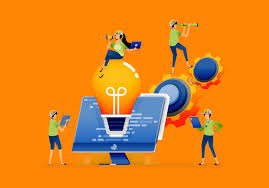Introduction to the Lack of Diversity in iOS App Development
Welcome, fellow tech enthusiasts and passionate app developers! Today, we embark on a journey that aims to break barriers and open doors for underrepresented groups in the world of iOS app development. Let’s face it: diversity is not just a buzzword; it’s an essential ingredient for innovation and progress in the tech industry.
In this blog post, we’ll explore why diversity matters in the realm of iOS app development, shed light on the challenges faced by underrepresented groups, and most importantly, provide strategies to foster inclusivity. So buckle up as we dive into this captivating topic that holds immense potential for transforming our digital landscape. Are you ready? Let’s get started!
The Importance of Diversity in the Tech Industry
The tech industry has become an integral part of our daily lives, shaping the way we communicate, work, and interact with the world. It is a dynamic and ever-evolving field that demands innovation and creativity. However, one issue that continues to persist is the lack of diversity within this sector.
Diversity in the tech industry is crucial for several reasons. It brings together individuals from different backgrounds and experiences, leading to a broader range of perspectives and ideas. This diversity can foster more innovative solutions to complex problems by encouraging collaboration and out-of-the-box thinking.
Diversity promotes inclusivity by ensuring that everyone has equal opportunities to contribute their unique talents and skills. By creating a supportive environment where individuals feel valued regardless of their race, gender identity, or socioeconomic background, companies can attract top talent from diverse communities.
Moreover, having a diverse workforce allows companies to better understand their customers’ needs and preferences. When developers come from different backgrounds, they bring insights into various cultures and demographics which can help create apps that cater to a wider audience.
Barriers Faced by Underrepresented Groups in iOS App Development
Underrepresented groups in iOS app development services face several barriers that hinder their participation and progression in the field. One of the main challenges is access to resources and opportunities. Many individuals from marginalized communities may not have access to quality education or training programs that teach them the necessary skills for app development.
Furthermore, there is a lack of diversity within existing networks and communities related to iOS app development. This can make it difficult for underrepresented groups to find mentorship or support systems that understand their unique experiences and challenges.
Another barrier faced by these groups is unconscious bias within the industry itself. Stereotypes and preconceived notions about who can be successful in tech often result in discriminatory practices during hiring processes or project assignments.
Additionally, limited representation in leadership roles can contribute to feelings of exclusion among underrepresented groups. When individuals do not see people like themselves at higher levels of success, it can be demotivating and reinforce the notion that they do not belong in this field.
Financial constraints can also act as a barrier for many individuals from marginalized backgrounds. The cost associated with attending coding bootcamps or acquiring necessary hardware/software tools may deter some aspiring developers from pursuing careers in iOS app development.
Despite these barriers, efforts are being made to address these issues through various initiatives such as scholarships, mentorship programs, and diversity-focused organizations. By providing equal opportunities for everyone interested in this field regardless of background, we can break down these barriers and foster an inclusive environment where diverse perspectives thrive.
Overcoming Challenges: Strategies for Fostering Diversity
Strategies for fostering diversity in the world of iOS app development are crucial to breaking down existing barriers and creating a more inclusive industry. One key approach is building awareness and education around the importance of diversity. This can be achieved through hosting workshops, conferences, or online resources that highlight the benefits of diverse perspectives in app development.
Mentorship programs also play a vital role in overcoming challenges faced by underrepresented groups. By pairing experienced developers with newcomers from diverse backgrounds, these programs provide support, guidance, and opportunities for growth. Mentors can share their knowledge and experience while helping mentees build confidence and navigate potential obstacles.
Creating safe spaces within the tech community is essential for fostering diversity. Organizations should establish policies against discrimination and harassment while actively promoting inclusivity. Encouraging open dialogue about experiences and concerns can help address issues head-on.
Another effective strategy is diversifying recruitment efforts. Companies should actively seek out talent from underrepresented groups through targeted outreach programs, partnerships with organizations focused on inclusion, or attending career fairs specifically tailored to diverse candidates.
Recognizing and celebrating success stories of those who have overcome barriers is important for inspiring others on their own journey in iOS app development. Sharing these stories will not only motivate aspiring developers but also showcase different paths to success.
By implementing these strategies collectively, we can foster an environment where everyone feels valued regardless of their background or identity – ultimately leading to more innovative iOS apps that cater to a wider range of users’ needs.
Success Stories: Examples of Diverse and Inclusive iOS Apps
Diversity in iOS app development has been responsible for some truly groundbreaking and inclusive applications. Let’s take a look at a few success stories that highlight the power of diversity in this industry.
One standout example is Be My Eyes, an app that connects blind or visually impaired individuals with sighted volunteers through video calls. This innovative app empowers those with visual impairments to gain assistance with everyday tasks, fostering inclusivity and independence like never before.
Another remarkable app is Proloquo2Go, designed for individuals with communication disabilities such as autism or cerebral palsy. This powerful tool allows users to communicate using customizable symbols and text-to-speech technology, providing them with a voice and enabling better social interactions.
An inspiring success story comes from A Color Story, developed by two women who recognized the need for more diverse photo editing options beyond filters created by traditional beauty standards. Their goal was to provide users with tools that celebrate all skin tones and hair colors, promoting inclusivity in the digital photography realm.
Additionally, Moovit stands out as an accessible navigation app tailored specifically for people with mobility challenges. By incorporating features such as step-free routes and real-time public transportation updates, Moovit ensures everyone can navigate their cities independently without barriers.
These are just a few examples of how diversity drives innovation within iOS app development field. It’s important to recognize these successes not only for their technical achievements but also for their positive impact on underrepresented communities.
Resources for Supporting and Promoting Diversity in iOS App Development
Promoting diversity in the world of iOS app development requires access to resources that can support underrepresented groups and empower them to succeed. Fortunately, there are several organizations, programs, and initiatives available that aim to bridge the gap and foster inclusivity within the tech industry.
One valuable resource is CodePath.org, a nonprofit organization dedicated to increasing diversity in technology fields. They offer free online courses specifically designed for underrepresented students, providing them with opportunities to learn essential skills needed for iOS app development. By removing financial barriers and offering mentorship programs, CodePath.org creates an environment where aspiring developers from all backgrounds can thrive.
Another useful resource is Women Who Code (WWC), a global nonprofit organization focused on empowering women in technology careers. WWC offers a variety of resources such as coding workshops, networking events, scholarships, and mentorship opportunities tailored specifically for women interested in iOS app development. These resources not only provide technical knowledge but also create a supportive community where women can connect with like-minded individuals.
In addition to external organizations, Apple itself provides resources through its various developer programs. The Apple Developer Academy’s Entrepreneur Camp focuses on supporting female founders who are creating innovative apps or expanding their existing businesses. This program provides hands-on guidance from experts at Apple along with access to technical labs and ongoing support even after completion.
Furthermore, conferences like AltConf provide platforms for diverse voices within the iOS app development community. These events feature talks by industry leaders who share their experiences as members of underrepresented groups while inspiring others who aspire to follow similar paths.
Conclusion
In today’s rapidly evolving world, diversity and inclusion are not just buzzwords; they are essential elements that drive innovation and success. When it comes to iOS app development, fostering diversity is crucial for creating more inclusive and user-friendly applications.
The lack of diversity in the tech industry has been a long-standing challenge, but by understanding the barriers faced by underrepresented groups and implementing strategies to overcome them, we can create a more diverse workforce in iOS app development.
By actively promoting diversity through recruitment practices, providing mentorship opportunities, offering training programs targeted towards underrepresented groups, and creating safe spaces for collaboration and idea-sharing, we can break down the barriers that hinder inclusivity.
It’s important to celebrate success stories of diverse and inclusive iOS apps. Whether it’s an educational app designed specifically for children from marginalized communities or a gaming application that promotes gender equality, these examples show us what is possible when different perspectives come together.
If you’re interested in supporting or promoting diversity in iOS app development further, there are various resources available. Organizations like Black Girls Code or Women Who Code provide valuable support networks and learning opportunities for individuals who want to pursue careers in technology. Additionally, conferences such as WWDC (Apple Worldwide Developers Conference) offer sessions focused on inclusivity in app design and development.





